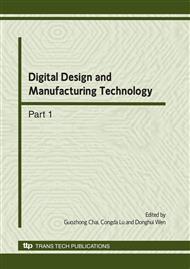p.573
p.578
p.583
p.587
p.591
p.595
p.600
p.605
p.610
Study on the Effect of Ultrasonic Surface Rolling Processing Parameters on the Surface Roughness of Q345 Hydraulic Prop
Abstract:
The surface roughness of the hydraulic prop had an important effect on the wear resistance, fatigue strength and property of fit. The ultrasonic surface rolling extrusion (USRE) processing experiment was employed to improve the surface roughness of the hydraulic prop, some machine parameters such as the tools transfer magnitude, feed were studied in detail, the contact style roughness tester( Mahr S2) was used to test the surface roughness of the workpiece. The experiment results showed that the USRE could improve the surface roughness evidently, the Ra value from 0.976μm reduce to 0.105 μm by one-hit machining. The feed was linear with the surface roughness, and when the tools’ amplitude was 6.5~8.5, there were a better surface roughness Ra 0.090μm. USRE processing the surface time and again could improve the surface state.
Info:
Periodical:
Pages:
591-594
Citation:
Online since:
March 2010
Authors:
Price:
Сopyright:
© 2010 Trans Tech Publications Ltd. All Rights Reserved
Share:
Citation:


